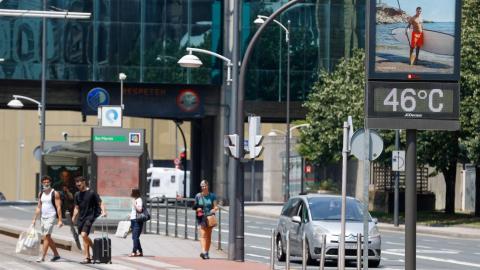Reactions: how to make cities that care for young people's mental health
Access to safe public spaces to meet, employment, education and public health are some of the main measures recommended to make cities more friendly to the mental health of young people and adolescents. The analysis, based on surveys of 518 people in several countries, is published in the journal Nature and is intended to serve as a guide for urban planning policies that reduce inequalities and take into account the needs of young people.

Mònica Ubalde López - ciudades salud mental EN
Mònica Ubalde López
Postdoctoral Researcher at the Barcelona Institute for Global Health (ISGlobal)
The study provides a multidisciplinary view that identifies priorities for a city that promotes and protects the mental health of young people and adolescents. The 518 participants, from 53 countries, different professional profiles and age groups, proposed an initial list of 134 characteristics of a youth-friendly city. The 40 preferred characteristics have been classified into six levels, following a conceptual model that combines social and environmental exposures in an urban setting and their interaction with adolescent development: personal, interpersonal, community, organisational (employment, health services), political and environmental relationships.
The authors conclude by identifying a set of priorities for cities that require intervention at multiple levels and in all urban sectors: providing young people with resources for personal and emotional development; developing and maintaining safe, healthy and strong intergenerational relationships; promoting integration and participation in all areas of community life; facilitating fulfilling and safe employment; inclusive and violence-free education; access to affordable housing; maintaining safe and free public spaces for socialisation, learning and connection; providing safe and reliable infrastructure for basic services and transport; city design for safety and protection for vulnerable groups, built for mental health promotion; access to green and blue space; access to recreation and the arts.
Finally, the authors propose as a next step the need to involve different stakeholders to build consensus, prioritise and plan the co-design of the implementation of the most salient features of a mental health friendly city for young people in specific cities.
The methodology and design of the study are sound. However, the study has some limitations such as the under-representation of the youth-adolescent group in the participant panel which has revealed differences in the priorities identified compared to older panellists. This discrepancy could have implications for policy design by decision-makers 'on behalf of young women and adolescent girls' and not listening to their voice, so that the interventions designed may not match what is most needed for them. Therefore, the participation of young people in policy development is even more crucial. Asking them more about what supports their mental health based on their personal experiences could simplify and improve interventions for this group. On the other hand, the participants do not reflect the full social and economic diversity of urban populations (academics, educators, leaders and well-connected youth), and the number of more vulnerable participants is minimised. Finally, the biased geographical representation to some geographical regions (e.g. North America and Nepal), may have generated biased responses dependent on cultural context. Complementing the findings of this work with qualitative studies, including co-creation processes with groups of adolescents and young people, in other geographic regions and in a local context, would contribute to identifying and understanding key nuances for the development of an urban environment that protects and promotes their mental health.
Mikel Subiza-Pérez - ciudades salud mental EN
Mikel Subiza-Pérez
Postdoctoral researcher at the University of the Basque Country (UPV/EHU)
City life offers many opportunities in terms of access to health services, the labour market or educational institutions. It also provides a wide range of leisure and recreational resources, as well as rich and diverse networks of support and friendship. However, it is also true that cities are unequal spaces with characteristics, such as less access to green spaces or safety, which can lead to mental health problems. Adolescence and youth are periods of particular importance in this respect, as these are often when the first difficulties appear that can later have a major impact on mental health throughout the rest of the life cycle.
Under these premises, and on the basis that the opinions and specific needs of this group are rarely taken into account when defining urban and social policies, a group of researchers from different countries carried out a series of surveys of 518 people. The aim of this work was to define the characteristics of cities that are friendly to the mental health of adolescents and young people. Through a three-phase survey, participants prioritised characteristics within six areas; personal, interpersonal, community, organisational, political and environmental. Examples of these characteristics were access to safe public spaces to meet and connect with others, 24-hour mental health care services, and the inclusion of mental health in policy making.
Despite its interest, the study presents two aspects that would need to be improved in the future in order to establish a greater consensus. Firstly, while young adults are well represented in the sample, there is a very small presence of adolescents (<1%). Secondly, we cannot know to what extent the results are globally generalisable as the vast majority of participants (63%) come from only three countries, Nepal, the United States and Kenya. There is very little representation from the other countries included.
Despite the above, this study helps to put the spotlight on people's mental health and their agency in deciding and designing the places they want to live in.
Filka Sekulova - ciudades salud mental EN
Filka Sekulova
Senior Researcher in Social Sciences, IN3/UOC
The study is based on the estimate that by 2050, 70% of young people will be living in cities, and on clear evidence of the worsening mental health associated with urban living. The research is based on a series of sequential surveys to identify and prioritise the characteristics of a city that contribute to young people's mental health, administered to 518 people in 53 countries.
As the start of the study coincided with the early months of covid-19 and the associated lock-in, the results capture the experiences of vulnerability and insecurity associated with the pandemic to some extent. The study highlights the importance of life skills development and personal development and emotional maturity for the mental health of young people (aged 18-35).
Another finding, in the domain of interpersonal relationships, is the importance of acceptance and respect for others, as well as access to safe meeting spaces. For example, people with good social networks, jobs and interpersonal relationships experienced the pandemic [in a] much milder way than others. One sees how the social isolation associated with the covid era clearly contributed to poor mental health. In this relationship, public policies that reduce bullying, harassment, abuse, censorship, exposure to violence and a wide range of threats are critical to mental health. In general, equity and discrimination on the basis of race, gender, sexual orientation and neurodiversity are closely linked to mental health. For example, a city free of discrimination and racism has been at the top of the list of policy proposals for a city that cares for mental health in interviews.
Access to employment, education and public health also emerge as key aspects of young people's mental health. Job loss is listed as one of the key factors that have a negative influence on mental health, a fact that is well established in the literature.
One of the recommendations, which also tends to emerge from other studies of this type, is that a city that respects mental health has low levels of discrimination and is committed to equity. The importance of green spaces, in particular, is highlighted as providing solace to young people, a finding shared by many other studies. Green spaces provide not only healthier living, but also opportunities for healthier socialisation.
However, well-intentioned policies (e.g. green spaces) might have negative effects on the mental health of young people, as long as they are designed under the influence of the market and increase environmental privilege and (green) gentrification. This result confirms series of other studies on the relationship between public health and gentrification, such as Anguelovski et al. 2021.
Helen Cole - ciudades salud mental EN
Helen Cole
Senior researcher at the Institute of Environmental Science and Technology (ICTA-UAB) of the Autonomous University of Barcelona
The article addresses the highly important and timely topic of supporting the mental health of adolescents and young adults. Unlike many published articles, the methods and content provide a breadth of ideas for future research ideas and for policy makers. Importantly, the research team engaged a variety of stakeholders—from youth themselves, to those working in urban planning and other fields supporting the work of healthy cities. The results would have been even more useful if there had been more reflection on the differences in responses between these stakeholders.
A critical backdrop to the study, which is not featured prominently enough in the title, abstract and conclusions of the article, is that the data collection took place toward the beginning of the Covid-19 pandemic. While the context of the pandemic is discussed, it deserves more focus and reflection regarding how the time period may have affected the results of the study, even statements not related directly to the pandemic, particularly in regard to mental health and even more so in regard to the mental health of adolescents and young adults.
One of the most important observations of the authors is one that is often identified as important, but which mostly eludes our abilities as public health practitioners. This is the need to address structural social inequities which result not just in inequities in mental health outcomes among young adults and adolescents (the topic of the article) but in all kinds of health inequities and other injustices across the age spectrum.
Pamela Y. Collins et al.
- Research article
- Peer reviewed



